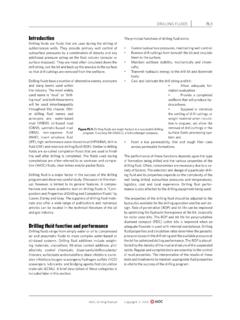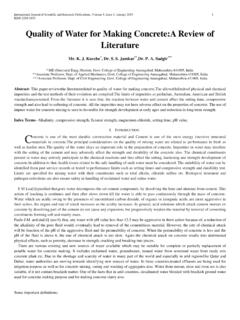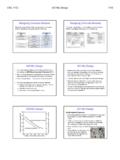Transcription of MOTION OF BUBBLES AND BUBBLE CHARACTERSTICS
1 MOTION OF BUBBLES AND BUBBLE CHARACTERSTICS BUBBLE Formation Size Formation is generally accomplished by passing air through an orifice. BUBBLE volume has been empirically determined as B2 RVg = (1) and radius 133Ra2g = (2) where VB = BUBBLE volume (ml or cm3) a = BUBBLE radius, cm R = orifice radius, cm = surface tension, dynes/cm g = gravitational constant, cm/sec2 = difference between , density of liquid in gram/cm3, and p, the density of the BUBBLE .
2 Accordingly, the radius of a BUBBLE is directly proportional to the surface tension and the radius of the orifice, and inversely proportional to the difference in densities between the liquid and gas. Temperature and viscosity have only marginal effects on BUBBLE diameters. Effect of Gas Flow Rate. BUBBLE size is fairly constant at low and medium gas flow rates where equations 1 and 2 apply but increases dramatically at high gas flow rates, and equations 1 and 2 are no longer valid. air flow rate Over the range of air rates normally encountered in aeration practice, the frequency of BUBBLE formation is nearly constant and the BUBBLE radius increases to account for the larger flow rate.
3 The mean radius of the BUBBLE produced can be modeled as an exponential function of the gas flow rate, a ~ G where a is the radius, Gs is the air flow rate, and n, the exponent, ranges from to sn Coalescence There are two types of liquids from the point of view of BUBBLE formation: Class A: BUBBLES formed will not recombine with adjacent BUBBLES Examples are aqueous solutions of alcohols, organic acids, ether, benzene, concentrated HNO3 and strong salt solutions. Class B: BUBBLES have a strong tendency to combine or coalesce. Examples are all viscous liquids, , olive oil, tap or distilled H2O, dilute salt solutions, and H2SO4 in all concentrations.
4 seawater is a good example. The transition from coalescence to non-coalescence (Class B to Class A) is 8 to 10 g/L. Therefore in tap water the BUBBLES coalesce and in sea water the BUBBLES would not recombine. You can observe this phenomenon by visiting a tropical fish store with both fresh and salt water aquariums. The BUBBLES are much smaller in the salt water aquariums. Another example are white caps in salt water and the absence of such foaming on freshwater lakes. BUBBLE Shape BUBBLE shape varies with the diameter and this is caused by the varying drag forces. Radius < cm solid spheres Radius to cm deviational from spherical Radius > cm ellipsoidal MOTION and Velocity of BUBBLES The regime of BUBBLE MOTION varies considerably with the Reynolds number, Re=Ua (3) where U = BUBBLE rise velocity a = BUBBLE radius = kinematic viscosity of fluid 1.
5 For Re < 1 a < cm Stokes Law Regime 21gaU3 = (4) where g is the gravity constant. BUBBLES rise vertically without oscillating. 2. For 1 < Re < 800 which occurs for BUBBLE radii from cm to cm. gaU~ (5) BUBBLES move in a helical fashion. 3. For Re = 800 and a > cm BUBBLES are ellipsoidal in shape, MOTION is irregular, and velocity is independent of BUBBLE diameter (U is approx.)
6 28 - 30 cm/sec) for BUBBLES having radii up to cm. For larger BUBBLES their velocity tends to increase to 35 - 40 cm/sec, but they are not stable and tend to subdivide into smaller BUBBLES . 0 10 30 20 40 (cm/sec) BUBBLE diameter, cm This should give a semi-quantitative indication of the size of BUBBLES that are formed and the rise velocity as a function of size. Unfortunately the number of BUBBLES expelled as a function of gas flow rate cannot be quantitatively described, and empirical methods must be utilized. EFFECT OF TEMPERATURE ON OXYGEN TRANSFER Aeration, mass transfer coefficients are influenced by temperature due to the effect on the diffusivity and viscosity.
7 20LL 20KK = T (6) or 20LL20Ka Ka =T (7) Reported values of range from to The most reliable estimates are for diffused aeration and for surface aeration. The ASCE standard uses , and this value must be used when doing a standard test. The rate of increase in KLa with temperature is greater than the increase in the rate of oxygen diffusivity due to the decrease in water viscosity with increasing temperature.
8 EFFECT OF SURFACE ACTIVE IMPURITIES ON GAS TRANSFER Many organic substances present in sewage are surface active, that is, they tend to adsorb or accumulate at the liquid-solid or liquid-gas interface. These compounds are called surfactants. Soaps and detergents are the most common. Surfactants have polar and non-polar parts of the molecule. The simplest has a polar end, often charged, and a non polar end, such as a hydrocarbon. The most common surfactant is soap, which was originally manufactured by mixing animal fat and lye (sodium hydroxide). The result is a surfactant with a negatively charged end (the sodium is released to solution as the balancing cation).
9 Hydrogen bonding among water molecules will gradually force the surfactant s non polar end to the surface. This happens because the polar ends of the water molecules attract each other, and squeeze the surfactant out of the way. The result is the surfactant at the interface ( , the air BUBBLE surrounded by water ) with the polar or charge end in the water and the non polar end protruding into the BUBBLE . The net effect is to reduce oxygen transfer in the area around the BUBBLE by reducing molecular diffusion of oxygen. The time required for adsorption varies with the surfactant type. Small surfactants such as acetic acid adsorb quickly.
10 The time to reach equilibrium depends upon many different properties, but is inversely proportional the molecular weight of the surfactant. The excess surface concentration can be calculated. For a small concentration, C, in the bulk phase the surface excess can be calculated as follows: CdRTdC = (8) where R = universal gas constant T = absolute temperature = surface excess (moles/cm3) C = concentration of solute = surface tension Basically there are four effects of surface active agents (SAA) on gas transfer: 1.








